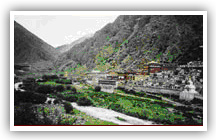Tibetan Buddhism Overview



Until the present day, the Buddhist traditions of Tibet have preserved completely the Hinayana and Mahayana schools of Buddhism, and also the unique Vajrayana transmission. The following are the Four Buddhist traditions of Tibet.
Nyingma Tradition
The Nyingma school of Tibetan Buddhism traces its origin to the Indian adept, Guru Padmasambhava. This is the oldest school of Tibetan Buddhism. It is based on a lineage of teachings and traditions introduced during the reigns of the Buddhist Kings of the Yarlong Dynasty in the eighth and ninth century by Padmasambhava, Shantarakshita, Vilalamitra, and others.
Kagyu Tradition
The particular feature of the Kagyu lineage is that the teacher, after having mastered the teachings, clears away defects - relating to intellectual understanding, and meditation experience, and the various levels of realization. Upon completion of the process, the teacher is able to point out and introduce Mahamudra to the disciple. The Kagyu teachings have been transmitted and preserved this way, in an unbroken line from Buddha Vajradhara to Tilopa (988-1069) until the present time H.H. XVII Gyalwa Karmapa Ogyen Drodul Trinley Dorje.
Sakya Tradition
The Sakya tradition originated in the eleventh century, and has been closely associated with the Khon Family. Khon Lui Wangpo Sungwa became a disciple of Guru Rinpoche in the eighth century. Through the next thirteen generations, the Dharma continued to be propagated through the Khon family. Sakya Monastery was built In 1073 by Khon Konchok Gyalpo who established the Sakya Tradition in Tibet. He studied under Drokmi the Translator (992-1072) and became a master of many deep teachings.
Gelug Tradition
This is lineage combines the teachings and practices of the Nyingma, Kagyu and Sakya with the Sutra and Tantra systems of Indian Buddhism and the intellectual heritage of Nagarjuna and Asanga. It was founded by Gyalwa Tsongkhapa (1357-1419). Tsongkhapa's disciple, Gyalwa Gedun Drupa was the first of the fourteen successive rebirths of the Dalai Lama. The present Dalai Lama is Tenzin Gyatso, known to his followers as Vajradhara Vagindra Sumati Shasana Dhara Samudra Shri Bhadra. He was given the Nobel Peace Prize in 1989 in recognition of his tireless efforts on behalf of world peace.